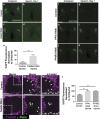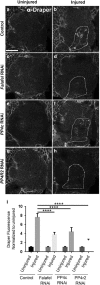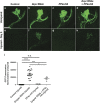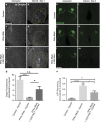Protein phosphatase 4 coordinates glial membrane recruitment and phagocytic clearance of degenerating axons in Drosophila
- PMID: 28230857
- PMCID: PMC5386485
- DOI: 10.1038/cddis.2017.40
Protein phosphatase 4 coordinates glial membrane recruitment and phagocytic clearance of degenerating axons in Drosophila
Abstract
Neuronal damage induced by injury, stroke, or neurodegenerative disease elicits swift immune responses from glial cells, including altered gene expression, directed migration to injury sites, and glial clearance of damaged neurons through phagocytic engulfment. Collectively, these responses hinder further cellular damage, but the mechanisms that underlie these important protective glial reactions are still unclear. Here, we show that the evolutionarily conserved trimeric protein phosphatase 4 (PP4) serine/threonine phosphatase complex is a novel set of factors required for proper glial responses to nerve injury in the adult Drosophila brain. Glial-specific knockdown of PP4 results in reduced recruitment of glia to severed axons and delayed glial clearance of degenerating axonal debris. We show that PP4 functions downstream of the the glial engulfment receptor Draper to drive glial morphogenesis through the guanine nucleotide exchange factor SOS and the Rho GTPase Rac1, revealing that PP4 molecularly couples Draper to Rac1-mediated cytoskeletal remodeling to ensure glial infiltration of injury sites and timely removal of damaged neurons from the CNS.
Conflict of interest statement
The authors declare no conflict of interest.
Figures








Similar articles
-
Insulin-like Signaling Promotes Glial Phagocytic Clearance of Degenerating Axons through Regulation of Draper.Cell Rep. 2016 Aug 16;16(7):1838-50. doi: 10.1016/j.celrep.2016.07.022. Epub 2016 Aug 4. Cell Rep. 2016. PMID: 27498858 Free PMC article.
-
Negative regulation of glial engulfment activity by Draper terminates glial responses to axon injury.Nat Neurosci. 2012 Mar 18;15(5):722-30. doi: 10.1038/nn.3066. Nat Neurosci. 2012. PMID: 22426252 Free PMC article.
-
Delayed glial clearance of degenerating axons in aged Drosophila is due to reduced PI3K/Draper activity.Nat Commun. 2016 Sep 20;7:12871. doi: 10.1038/ncomms12871. Nat Commun. 2016. PMID: 27647497 Free PMC article.
-
Keeping the CNS clear: glial phagocytic functions in Drosophila.Glia. 2011 Sep;59(9):1304-11. doi: 10.1002/glia.21098. Epub 2010 Dec 6. Glia. 2011. PMID: 21136555 Review.
-
Glial phagocytosis in developing and mature Drosophila CNS: tight regulation for a healthy brain.Curr Opin Immunol. 2020 Feb;62:62-68. doi: 10.1016/j.coi.2019.11.010. Epub 2019 Dec 18. Curr Opin Immunol. 2020. PMID: 31862622 Review.
Cited by
-
Neuronal fragile X mental retardation protein activates glial insulin receptor mediated PDF-Tri neuron developmental clearance.Nat Commun. 2021 Feb 19;12(1):1160. doi: 10.1038/s41467-021-21429-4. Nat Commun. 2021. PMID: 33608547 Free PMC article.
-
PP4-dependent HDAC3 dephosphorylation discriminates between axonal regeneration and regenerative failure.EMBO J. 2019 Jul 1;38(13):e101032. doi: 10.15252/embj.2018101032. Epub 2019 May 22. EMBO J. 2019. PMID: 31268609 Free PMC article.
-
Glial Regulation of Circuit Wiring, Firing, and Expiring in the Drosophila Central Nervous System.Cold Spring Harb Perspect Biol. 2024 Dec 2;16(12):a041347. doi: 10.1101/cshperspect.a041347. Cold Spring Harb Perspect Biol. 2024. PMID: 38565270 Free PMC article. Review.
-
Experience-dependent glial pruning of synaptic glomeruli during the critical period.Sci Rep. 2024 Apr 20;14(1):9110. doi: 10.1038/s41598-024-59942-3. Sci Rep. 2024. PMID: 38643298 Free PMC article.
-
Sphingosine-1-phosphate, a novel TREM2 ligand, promotes microglial phagocytosis to protect against ischemic brain injury.Acta Pharm Sin B. 2022 Apr;12(4):1885-1898. doi: 10.1016/j.apsb.2021.10.012. Epub 2021 Oct 22. Acta Pharm Sin B. 2022. PMID: 35847502 Free PMC article.
References
Publication types
MeSH terms
Substances
Grants and funding
LinkOut - more resources
Full Text Sources
Other Literature Sources
Molecular Biology Databases
Research Materials

